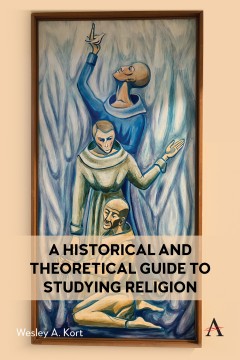A Historical and Theoretical Guide to Studying Religion
By Wesley Kort
Other Formats Available:
- About This Book
- Reviews
- Author Information
- Series
- Table of Contents
- Links
- Podcasts
About This Book
The book has two, related parts: the first historical and the second theoretical. The first part traces the beginning of “religious studies,” as it now increasingly is called, to the early nineteenth century. It places those beginnings in the broader cultural context of what is generally referred to as Romanticism. A case is made that the principal relations between the origins of religious studies and Romanticism is that both arise as reactions to major characteristics of modern culture, primarily the turn of attention away from the past and toward the future and from textuality toward rationality and materiality, including the separation of the two from one another.
The first or historical half of the book is structured by three recurring and enduring interests in religion by scholars, mainly working in the social or human sciences, including history, that are shared during the period and continue, albeit in more complex and varied forms, today. The first of these three interests is the importance for religious people of the past and its continuing relevance to their present and future. This interest and evaluation of the past and origins is, either directly or implicitly, contrasted to Western modernity’s orientation to the future and neglect and devaluing of the past. The second interest or focus is on the emphasis among religious people on the intangible or spiritual in human lives and cultures. This interest is, either directly or by implication, a reaction to the importance in modernity that is ascribed to the tangible and material. The third interest taken by scholars in the cultures of religious societies is the adequacy and coherence of worldviews that they provide, which stand in contrast to the lack in modern culture of worldviews that have a comparable degree of coherence and adequacy. These three interests are treated by including for each of them brief sketches of the work of five scholars arranged in chronological order. The conclusion drawn from these surveys of fifteen scholars from the beginning of the nineteenth century and into the twentieth century, most of whom were working in the social or human sciences, is that they shared an interest in human needs, potentials, and well being and a recognition that in various ways and to varying degrees modern culture is questionable due to its inability to provide what can be seen as an active aspect of religiously constituted cultures, particularly those of peoples not affected by the principal characteristics of Western modernity. The conclusion drawn is that religion has provided and continues for many to provide benefits that modernity otherwise fails to provide and that if religion can no longer play this role, something else must or will be found to fill the need or provide the benefits that religion once provided.
The second or theoretical part of the book addresses questions and problems that appear in and for the study of religion. One of these is the question of what must be included if a person or a people is identified as religious. It is argued that an adequate answer to this question is a more complex and dynamic understanding of religion than is generally the case, that definitions of religion tend to be too simple and static. The case is made that there are three necessary and sufficient aspects or components of being religious. Another question addressed in this second part is why religion is so often marked by sharp differences, tensions, and even conflicts within a single religion, between differing religions, and between religious and nonreligious groups or people. Another question treated in this part concerns the differences that arise between studying religion while being religious and studying religion while being nonreligious.
The two parts of the book are held together by the recurring attention that is given to the last of these questions, that is, the difference between studying religion while being religious and studying religion in nonreligious or secular ways. The case is made that this problem, the relations of religious and nonreligious study of religion to one another, has troubled the field from its beginnings. The development of the field as presented in the first part of the book was carried on largely by scholars who, even when not themselves religious, saw religion as having had beneficial relations to human well being. But by the middle of the twentieth century, it became clear that religion as part of human life and culture in the West needed more directly to be religiously supported, and faculties of religious studies in higher education were formed or enlarged by scholars who had, for reasons given, more explicitly religious bases for their studies of religion. This difference within the field between religious and secular study of religion threatens the field’s coherence; one overarching purposes of the book is to identify how and why a greater rapprochement between the two sides is both badly needed and, if guided by the book, approachable.
Reviews
Author Information
Wesley A Kort is Professor Emeritus of Religion at Duke University.
Series
Anthem Religion and Society Series
Table of Contents
Preface; Introduction; Part One: Historical; 1. Modernity, Romanticism, and the Rise of Religious Studies; 2. Studying Religion and Cultural Faults Caused by Repression and Neglect; 3. Studying Religion and the Lack of Cultural Accesses to Needed Intangibles; 4. Studying Religion and the Cultural Need for More Adequate Worldviews; Part Two: Theoretical; 5. The Object of Religious Studies;6. The Position of the Person Studying Religion; 7. Taking into Account Religion’s Excesses and Complexities; 8. Studying Religion while Being Religious; Conclusion; Index
Links
Stay Updated
Information
Latest Tweets



